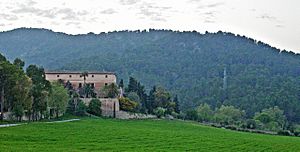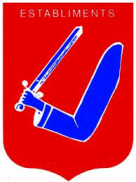Establiments facts for kids
Establiments is a neighborhood located in the Balearic Islands, which are a group of islands off the coast of Spain. It's found to the northwest of Palma de Mallorca, a major city on the island. The name "Establiments" comes from a word in the Catalan language that means "establishments" or "settlements." It's a place where many people live, with a mix of old history and modern life.
Contents
History of Establiments
The story of Establiments goes back a long time, even though the neighborhood itself started in the 1500s. People lived in this area much earlier than that.
Ancient Times
Scientists have found very old remains in caves like Son Bauçà and Ca’n Mallol. They also found talaiòtic remains. These are structures built by ancient people who lived on the islands thousands of years ago.
Farming and Estates
For many centuries, from about the 700s to the 1400s AD, a large part of Spain was under Muslim rule. During this time, farming really grew in the Establiments area.
Later, when the Kingdom of Aragon took over Mallorca, the land was given to a person named Nunó Sanç. For hundreds of years, the land was organized into large farming estates called "possessions." Establiments grew out of smaller pieces of these big estates. The name "Establiments" itself comes from the Mallorquin dialect of Catalan, meaning "establishments" or "properties."
One of the first big estates to be divided was called Son Gual. This area is now known as Establiments Vells, or "Old Establiments." It was also called El Rutló. Records show that in 1584, El Rutló had 14 smaller plots of land. Later, in the 1600s, another area called d'es Muntant from the Sarrià estate began to be divided. This area became known as Establiments Nous, or "New Establiments." By 1685, the "Old Establiments" had 69 plots, and the "New Establiments" had 33.
Becoming Independent
For a long time, Establiments was part of a nearby town called Esporles. But eventually, it became its own separate town. A map from 1785 by Cardenal Despuig shows many large estates in the area. These included Es Canyar, Son Cotoneret, Son Gual, Bunyolí, Sarrià, Son Morlà, Son Mallol, and Son Berga. Most of these estates were owned by important noble families. In 1776, a beautiful estate called Son Berga Nou was built. It was owned by the Safortesa family and is still considered one of Mallorca's most lovely estates.
In 1837, Establiments officially separated from Esporles and became its own independent municipality. By 1847, it had about 1,460 people living in 367 houses. The area covered about 22.55 square kilometers (8.7 square miles). Throughout the 1800s, most people in Establiments worked in farming. They grew crops like wheat, barley, almonds, olives for oil, carob beans, and other vegetables. Some of the largest estates during the 1870s were Sarrià (426 hectares), Bunyolí (376 hectares), Son Gual (195 hectares), Son Morlà (95 hectares), and Es Canyar (84 hectares).
Modern Changes
In the early 1900s, new businesses came to Establiments. Three fabric factories, a shoe factory, and a mosaics factory opened.
In 1910, Establiments became part of Palma de Mallorca and was officially called a neighborhood. It kept many of its original features, much like the nearby neighborhood of Son Espanyol. It's thought that this change happened because of money problems and disagreements between different political groups at the time.
In 1926, Establiments got an electric tram line. The tram cars left from Sant Miquel Street and helped people travel. This tram ran until 1959, when buses took its place. In 1933, a cement factory owned by Joan Colom started digging for materials in quarries. This caused some problems for the area.
During the Spanish Civil War, which was a difficult time in Spain, some important people from Establiments faced hardship. Antoni Roca Lladó, who was a leader of young socialists, and Gabriel Calafell Serra, a socialist from Esporles who lived in Establiments, were put in prison and sadly died. Because of these events, some residents had to leave their homes to find safety.
In the 1950s, tourism grew a lot on the island. This meant that less farming happened in Establiments, and many factories closed down. Many people from other parts of Spain moved to the area. The local people sometimes called these newcomers forasters, which means "strangers" in Catalan.
Where Establiments Is Located
The Establiments neighborhood shares its borders with other towns and areas. To the north, it borders the municipality of Esporles. To the west, it borders Puigpuñent. To the south, it is next to the districts of Son Anglada and Secar de la Real. To the east, it borders the suburb of Son Espanyol.
Coat of Arms
The Coat of arms for Establiments is a special symbol. It shows a blue arm holding a sword, all painted on a red background. This symbol represents the history and spirit of the area.
See also
 In Spanish: Establiments para niños
In Spanish: Establiments para niños



